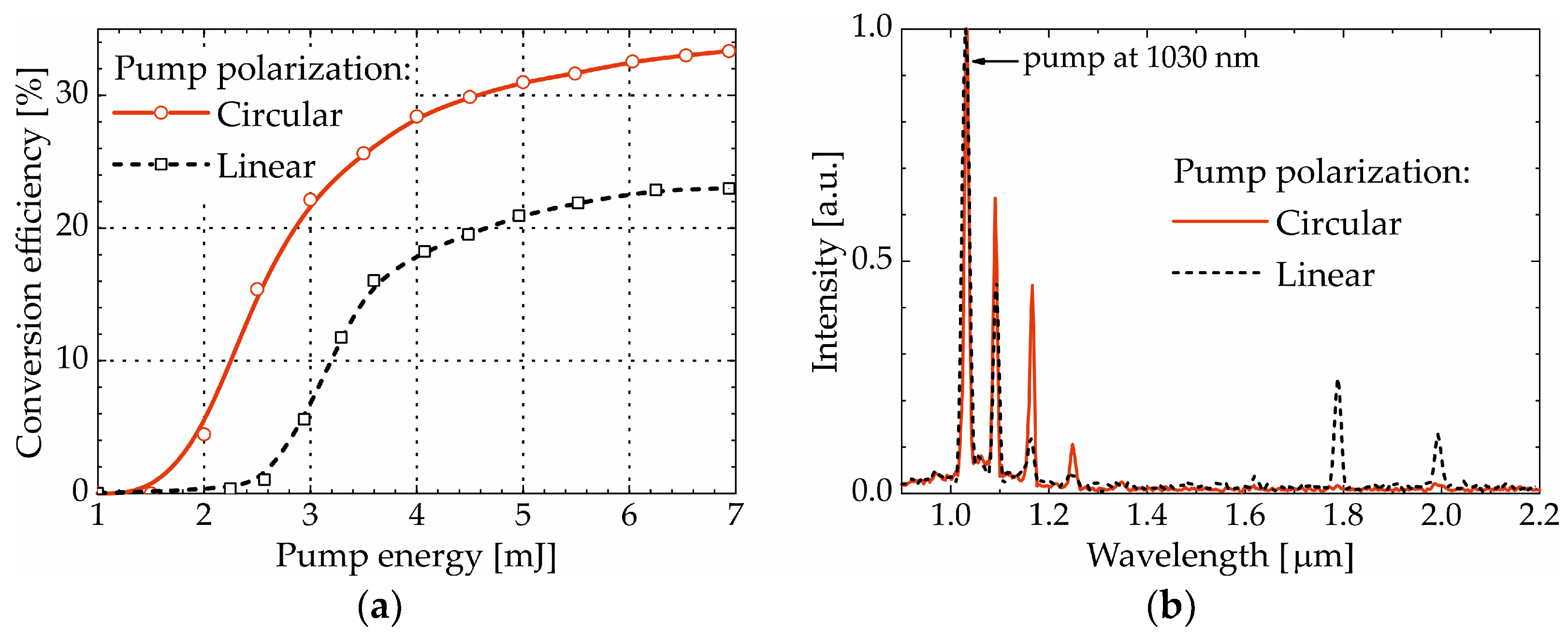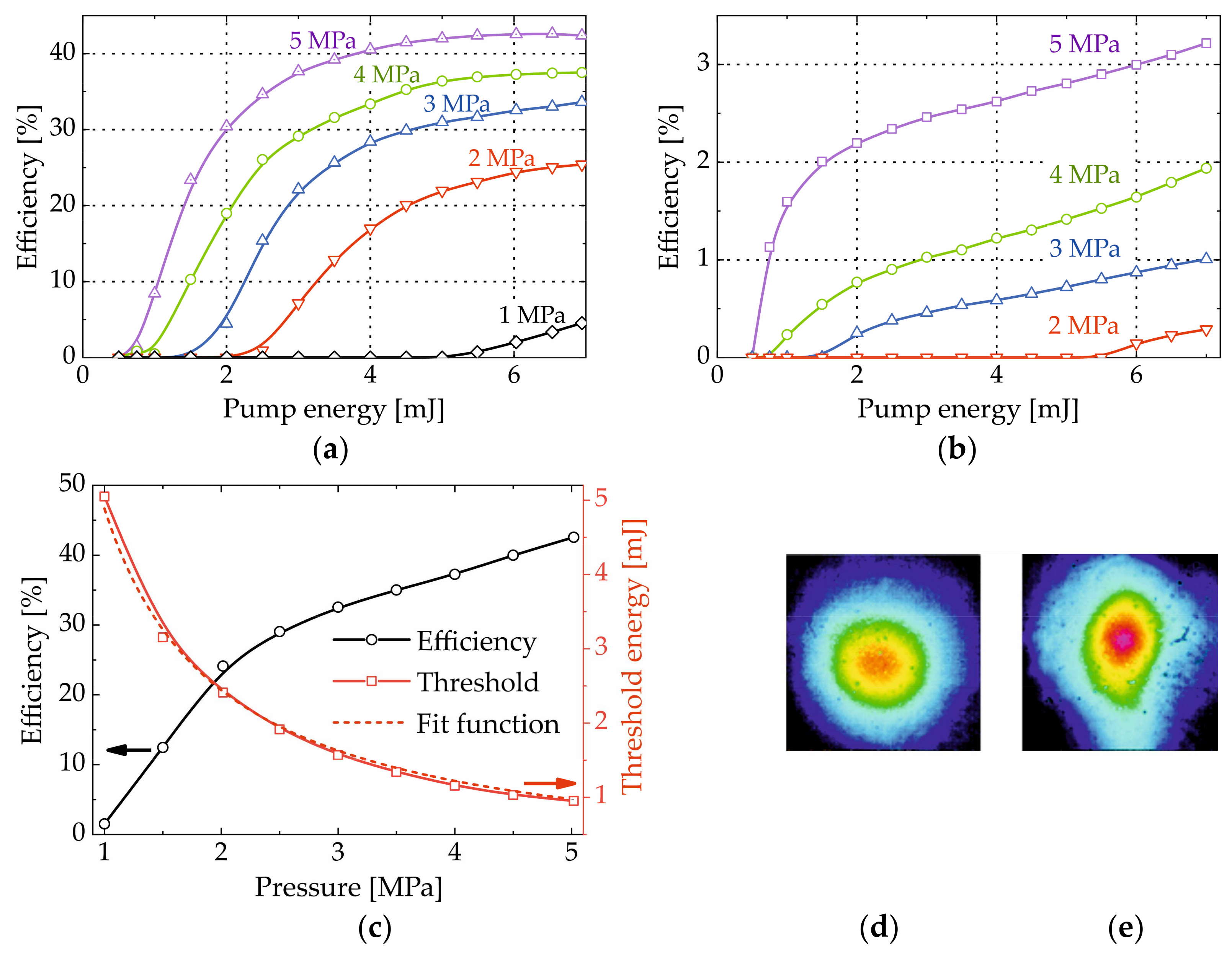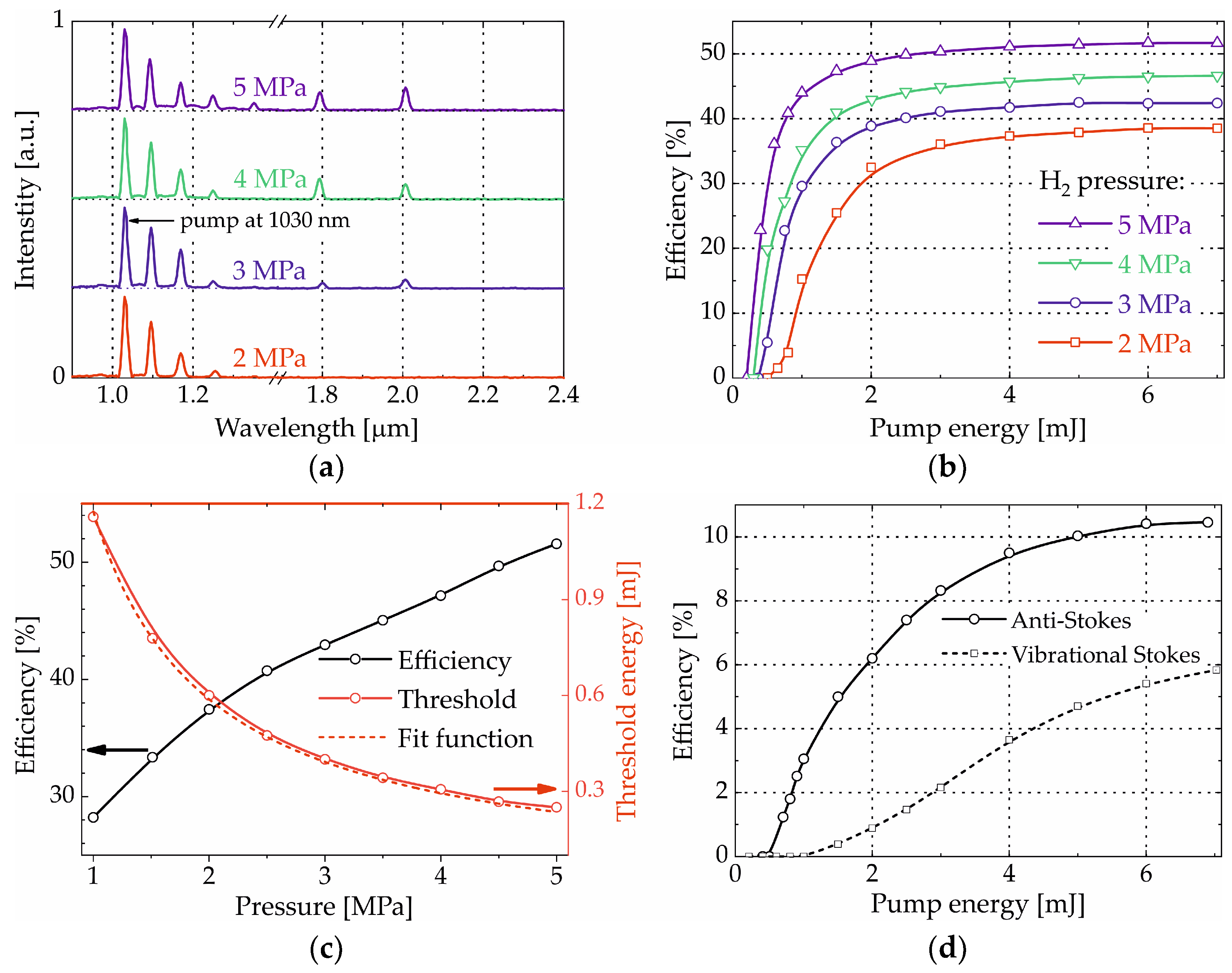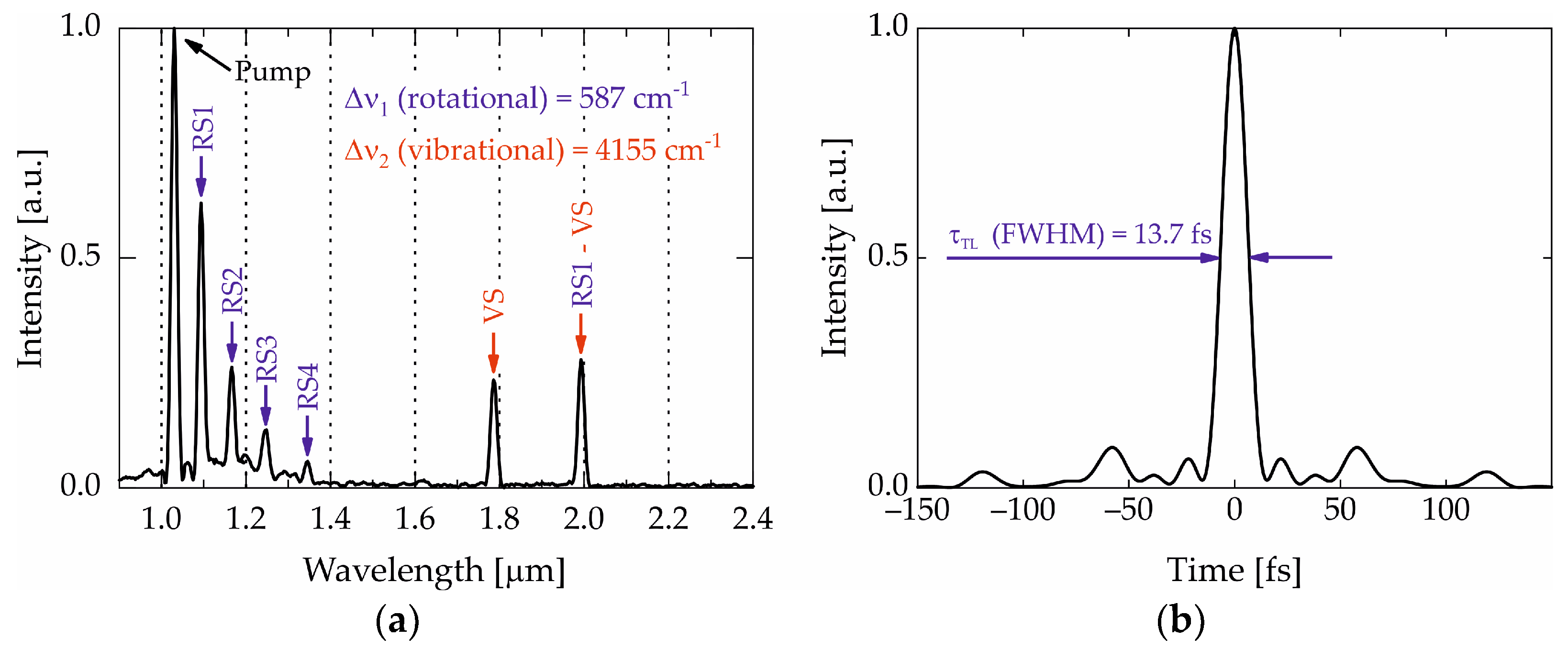Amplification of Supercontinuum Seed Pulses at ~1078–1355 nm by Cascade Rotational SRS in Compressed Hydrogen
Abstract
:1. Introduction
2. Experiment
3. Results and Discussion
3.1. Stimulated Rotational Raman Scattering in Compressed H2
3.2. Stimulated Rotational Raman Amplification of Supercontinuum Seed in Compressed H2
3.3. Compression of Output Pulses after Stimulated Rotational Raman Amplification
4. Conclusions
Author Contributions
Funding
Institutional Review Board Statement
Informed Consent Statement
Data Availability Statement
Acknowledgments
Conflicts of Interest
References
- Perillo, E.; Jarrett, J.; Liu, Y.L.; Hassan, A.; Fernée, D.C.; Goldak, J.R.; Bonteanu, A.; Spence, D.J.; Yeh, H.C.; Dunn, A.K. Two-color multiphoton in vivo imaging with a femtosecond diamond Raman laser. Light Sci. Appl. 2017, 6, e17095. [Google Scholar] [CrossRef] [PubMed]
- Kobat, D.; Horton, N.G.; Xu, C. In vivo two-photon microscopy to 1.6-mm depth in mouse cortex. J. Biomed. Opt. 2011, 16, 106014. [Google Scholar] [CrossRef] [PubMed]
- Horton, N.G.; Wang, K.; Kobat, D.; Clark, C.G.; Wise, F.W.; Schaffer, C.B.; Xu, C. In vivo three-photon microscopy of subcortical structures within an intact mouse brain. Nat. Photonics 2013, 7, 205–209. [Google Scholar] [CrossRef]
- Chen, M.C.; Arpin, P.; Popmintchev, T.; Gerrity, M.; Zhang, B.; Seaberg, M.; Popmintchev, D.; Murnane, M.M.; Kapteyn, H.C. Bright, Coherent, Ultrafast Soft X-Ray Harmonics Spanning the Water Window from a Tabletop Light Source. Phys. Rev. Lett. 2010, 105, 173901. [Google Scholar] [CrossRef] [PubMed]
- Clerici, M.; Peccianti, M.; Schmidt, B.E.; Caspani, L.; Shalaby, M.; Giguere, M.; Lotti, A.; Couairon, A.; Legare, F.; Ozaki, T.; et al. Wavelength Scaling of Terahertz Generation by Gas Ionization. Phys. Rev. Lett. 2013, 110, 253901. [Google Scholar] [CrossRef] [PubMed]
- Vicario, C.; Ovchinnikov, A.V.; Ashitkov, S.I.; Agranat, M.B.; Fortov, V.E.; Hauri, C.P. Generation of 0.9-mJ THz pulses in DSTMS pumped by a Cr:Mg2SiO4 laser. Opt. Lett. 2014, 39, 6632–6635. [Google Scholar] [CrossRef]
- Gaumnitz, T.; Jain, A.; Pertot, Y.; Huppert, M.; Jordan, I.; Ardana-Lamas, F.; Wörner, H.J. Streaking of 43-attosecond soft-X-ray pulses generated by a passively CEP-stable mid-infrared driver. Opt. Express 2017, 25, 27506–27518. [Google Scholar] [CrossRef]
- Yin, Y.; Li, J.; Ren, X.; Zhao, K.; Wu, Y.; Cunningham, E.; Chang, Z. High-efficiency optical parametric chirped-pulse amplifier in BiB3O6 for generation of 3 mJ, two-cycle, carrier-envelope-phase-stable pulses at 1.7 μm. Opt. Lett. 2016, 41, 1142–1145. [Google Scholar] [CrossRef]
- Andriukaitis, G.; Balciunas, T.; Alisauskas, S.; Pugzlys, A.; Baltuska, A.; Popmintchev, T.; Chen, M.C.; Murnane, M.M.; Kapteyn, H.C. 90 GW peak power few-cycle mid-infrared pulses from an optical parametric amplifier. Opt. Lett. 2011, 36, 2755–2757. [Google Scholar] [CrossRef]
- Baker, S.; Walmsley, I.; Tisch, J.; Marangos, J. Femtosecond to attosecond light pulses from a molecular modulator. Nat. Photonics 2011, 5, 664–671. [Google Scholar] [CrossRef]
- Yoshikawa, S.; Imasaka, T. A new approach for the generation of ultrashort optical pulses. Opt. Commun. 1993, 96, 94–98. [Google Scholar] [CrossRef]
- Garmire, E.; Pandarese, F.; Townes, C.H. Coherently driven molecular vibrations and light modulation. Phys. Rev. Lett. 1963, 11, 160–161. [Google Scholar] [CrossRef]
- Stewart, R.B.; Kung, R.T.V. A kilohertz repetition rate 1.9 μm H2 Raman oscillator. IEEE J. Quantum Electron. 1989, 25, 2142–2148. [Google Scholar] [CrossRef]
- Petrov, D.V.; Matrosov, I.I.; Zaripov, A.R.; Maznoy, A.S. Effects of pressure and composition on Raman spectra of CO-H2-CO2-CH4 mixtures. Spectrochim. Acta Part A: Mol. Biomol. Spectrosc. 2019, 215, 363–370. [Google Scholar] [CrossRef] [PubMed]
- Cai, X.L.; Xu, M.; Jia, Y.X.; Liu, J.B.; Wang, P.Y.; Chen, Y.; Gai, B.D.; Tan, Y.; Cai, H.X.; Guo, J.W. Stimulated vibrational–rotational Raman scattering of hydrogen pumped at a 1064-nm laser. Appl. Opt. 2023, 62, 1274–1278. [Google Scholar] [CrossRef]
- Cui, Y.; Huang, W.; Li, Z.; Zhou, Z.; Wang, Z. High-efficiency laser wavelength conversion in deuterium-filled hollow-core photonic crystal fiber by rotational stimulated Raman scattering. Opt. Express 2019, 27, 30396–30404. [Google Scholar] [CrossRef]
- Yavuz, D.; Walker, D.; Shverdin, M.; Yin, G.; Harris, S. Quasiperiodic Raman Technique for ultrashort pulse generation. Phys. Rev. Lett. 2003, 91, 233602. [Google Scholar] [CrossRef]
- Rodin, A.M.; Dement’ev, A.S. Development of a 2-color laser based on high-efficiency Raman amplification for multicolor holography. Proc. SPIE 1998, 3358, 211–217. [Google Scholar] [CrossRef]
- Krylov, V.; Rebane, A.; Ollikainen, O.; Erni, D.; Wild, U.; Bespalov, V.; Staselko, D. Stimulated Raman scattering in hydrogen by frequency-doubled amplified femtosecond Ti:sapphire laser pulses. Opt. Lett. 1996, 21, 381–383. [Google Scholar] [CrossRef]
- Koprinkov, G.; Suda, A.; Midorikawa, K. Interference between stimulated Raman scattering and self-phase modulation in pressurized methane in highly transient femtosecond pump regime. Opt. Commun. 2000, 174, 299–304. [Google Scholar] [CrossRef]
- Minck, R.W.; Hagenlocker, E.E.; Rado, W.G. Stimulated Pure Rotational Raman Scattering in Deuterium. Phys. Rev. Lett. 1966, 17, 229. [Google Scholar] [CrossRef]
- Morozov, V.B.; Olenin, A.N.; Tunkin, V.G. Transformation of strong picosecond pulses in radiation with an extended quasirotational spectrum during self-focusing in high-pressure hydrogen. J. Exp. Theor. Phys. 1999, 88, 263–271. [Google Scholar] [CrossRef]
- Kawano, H.; Hirakawa, Y.; Imasaka, T. Generation of high-order rotational lines in hydrogen by four-wave Raman mixing in the femtosecond regime. IEEE J. Quantum Electron. 1998, 34, 260–268. [Google Scholar] [CrossRef]
- Truong, T.C.; Beetar, J.E.; Chini, M. Light-field synthesizer based on multidimensional solitary states in hollow-core fibers. Opt. Lett. 2023, 48, 2397–2400. [Google Scholar] [CrossRef]
- Kirchner, M.D.; Shumakova, V.; Coccia, G.; Kaksis, E.; Schmidt, B.E.; Pervak, V.; Pugzlys, A.; Baltuška, A.; Zeiler, M.K.; Carpeggiani, P.A. HHG at the Carbon K-Edge Directly Driven by SRS Red-Shifted Pulses from an Ytterbium Amplifier. ACS Photonics 2022, 10, 84–91. [Google Scholar] [CrossRef]
- Mackonis, P.; Rodin, A.M. Laser with 1.2 ps, 20 mJ pulses at 100 Hz based on CPA with a low doping level Yb:YAG rods for seeding and pumping of OPCPA. Opt. Express 2020, 28, 1261–1268. [Google Scholar] [CrossRef] [PubMed]
- Moriwaki, H.; Wada, S.; Tashiro, H.; Toyoda, K.; Kasai, A.; Nakamura, A. Wavelength conversion of quadrupled Nd:YAG laser emission to the vacuum ultraviolet by anti-Stokes stimulated Raman scattering. J. Appl. Phys. 1993, 74, 2175–2179. [Google Scholar] [CrossRef]
- Jang, J.; Stratt, R.M. Dephasing of individual rotational states in liquids. J. Chem. Phys. 2000, 113, 11212–11221. [Google Scholar] [CrossRef]
- Hilfer, G.; Menyuk, C.R. Stimulated Raman scattering in the transient limit. J. Opt. Soc. B 1990, 7, 739–749. [Google Scholar] [CrossRef]
- Venkin, G.V.; Il’Inskiĭ, Y.A.; Mikheev, G.M. Influence of the polarization of radiation on the energy characteristics and threshold of stimulated Raman scattering due to rotational transitions. Sov. J. Quantum Electron. 1985, 15, 395–397. [Google Scholar] [CrossRef]
- Hanna, D.C.; Pointer, D.J.; Pratt, D.J. Stimulated Raman scattering of picosecond light pulses in hydrogen, euterium, and methane. IEEE J. Quantum Electron. 1986, 22, 332–336. [Google Scholar] [CrossRef]
- Börzsönyi, Á.; Heiner, Z.; Kovács, A.P.; Kalashnikov, M.P.; Osvay, K. Measurement of pressure dependent nonlinear refractive index of inert gases. Opt. Express 2010, 18, 25847–25854. [Google Scholar] [CrossRef] [PubMed]
- Mackonis, P.; Petrulenas, A.; Rodin, A.M.; Girdauskas, V.; Michailovas, A. Two-stage transient stimulated Raman chirped-pulse amplification in KGd(WO4)2 with compression to 145 fs. Opt. Lett. 2020, 45, 6627–6630. [Google Scholar] [CrossRef] [PubMed]
- Zheng, J.; Katsuragawa, M. Freely designable optical frequency conversion in Raman-resonant four-wave-mixing process. Sci. Rep. 2015, 5, 8874. [Google Scholar] [CrossRef]
- Pandiri, K.R.; Suzuki, T.; Suda, A.; Midorikawa, K.; Katsuragawa, M. Line-by-line control of 10-THz-frequency-spacing Raman sidebands. Opt. Express 2010, 18, 732–739. [Google Scholar] [CrossRef]







| Peak Position, nm | Raman Shift, cm−1 | Mode Assignment | Designation |
|---|---|---|---|
| 1096 | 587 | Rotational first-order Stokes | RS1 |
| 1166 | 1174 | Rotational second-order Stokes | RS2 |
| 1252 | 1761 | Rotational third-order Stokes | RS3 |
| 1351 | 2348 | Rotational fourth-order Stokes | RS4 |
| 1795 | 4155 | Vibrational Stokes from a pump pulse | VS |
| 1997 | 4742 | Vibrational Stokes from rotational first-order Stokes | RS1-VS |
Disclaimer/Publisher’s Note: The statements, opinions and data contained in all publications are solely those of the individual author(s) and contributor(s) and not of MDPI and/or the editor(s). MDPI and/or the editor(s) disclaim responsibility for any injury to people or property resulting from any ideas, methods, instructions or products referred to in the content. |
© 2023 by the authors. Licensee MDPI, Basel, Switzerland. This article is an open access article distributed under the terms and conditions of the Creative Commons Attribution (CC BY) license (https://creativecommons.org/licenses/by/4.0/).
Share and Cite
Petrulėnas, A.; Mackonis, P.; Černeckytė, A.; Rodin, A.M. Amplification of Supercontinuum Seed Pulses at ~1078–1355 nm by Cascade Rotational SRS in Compressed Hydrogen. Appl. Sci. 2023, 13, 13087. https://doi.org/10.3390/app132413087
Petrulėnas A, Mackonis P, Černeckytė A, Rodin AM. Amplification of Supercontinuum Seed Pulses at ~1078–1355 nm by Cascade Rotational SRS in Compressed Hydrogen. Applied Sciences. 2023; 13(24):13087. https://doi.org/10.3390/app132413087
Chicago/Turabian StylePetrulėnas, Augustinas, Paulius Mackonis, Augustė Černeckytė, and Aleksej M. Rodin. 2023. "Amplification of Supercontinuum Seed Pulses at ~1078–1355 nm by Cascade Rotational SRS in Compressed Hydrogen" Applied Sciences 13, no. 24: 13087. https://doi.org/10.3390/app132413087





